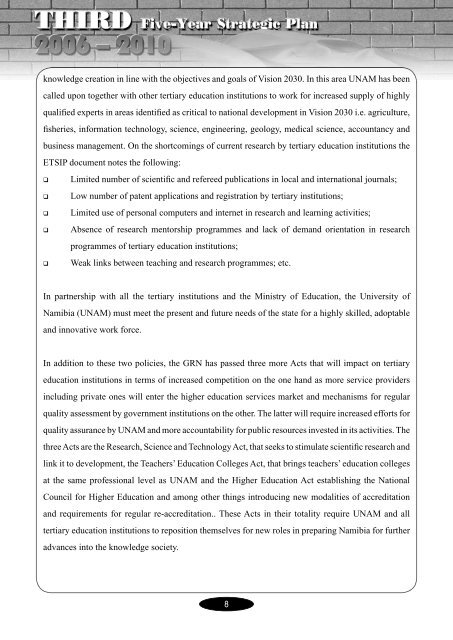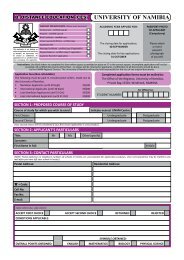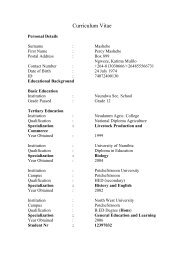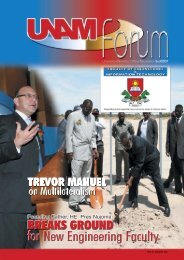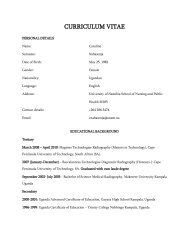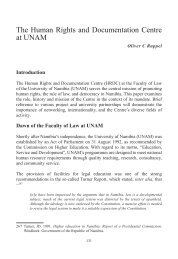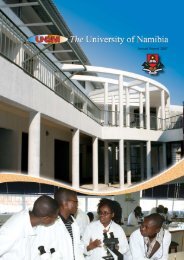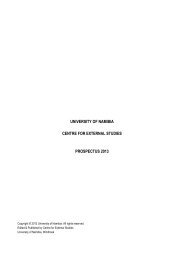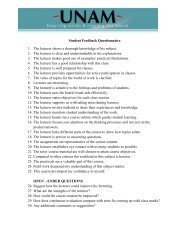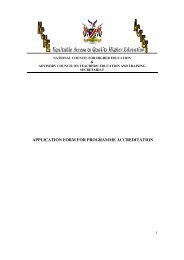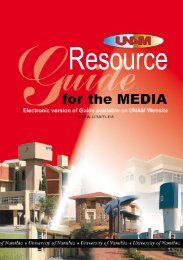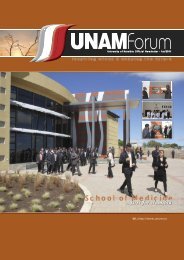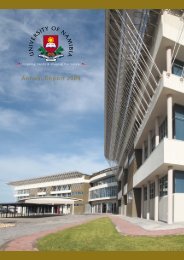5Year Strategic Plan - University of Namibia
5Year Strategic Plan - University of Namibia
5Year Strategic Plan - University of Namibia
You also want an ePaper? Increase the reach of your titles
YUMPU automatically turns print PDFs into web optimized ePapers that Google loves.
knowledge creation in line with the objectives and goals <strong>of</strong> Vision 2030. In this area UNAM has been<br />
called upon together with other tertiary education institutions to work for increased supply <strong>of</strong> highly<br />
qualified experts in areas identified as critical to national development in Vision 2030 i.e. agriculture,<br />
fisheries, information technology, science, engineering, geology, medical science, accountancy and<br />
business management. On the shortcomings <strong>of</strong> current research by tertiary education institutions the<br />
ETSIP document notes the following:<br />
<br />
<br />
<br />
<br />
<br />
Limited number <strong>of</strong> scientific and refereed publications in local and international journals;<br />
Low number <strong>of</strong> patent applications and registration by tertiary institutions;<br />
Limited use <strong>of</strong> personal computers and internet in research and learning activities;<br />
Absence <strong>of</strong> research mentorship programmes and lack <strong>of</strong> demand orientation in research<br />
programmes <strong>of</strong> tertiary education institutions;<br />
Weak links between teaching and research programmes; etc.<br />
In partnership with all the tertiary institutions and the Ministry <strong>of</strong> Education, the <strong>University</strong> <strong>of</strong><br />
<strong>Namibia</strong> (UNAM) must meet the present and future needs <strong>of</strong> the state for a highly skilled, adoptable<br />
and innovative work force.<br />
In addition to these two policies, the GRN has passed three more Acts that will impact on tertiary<br />
education institutions in terms <strong>of</strong> increased competition on the one hand as more service providers<br />
including private ones will enter the higher education services market and mechanisms for regular<br />
quality assessment by government institutions on the other. The latter will require increased efforts for<br />
quality assurance by UNAM and more accountability for public resources invested in its activities. The<br />
three Acts are the Research, Science and Technology Act, that seeks to stimulate scientific research and<br />
link it to development, the Teachers’ Education Colleges Act, that brings teachers’ education colleges<br />
at the same pr<strong>of</strong>essional level as UNAM and the Higher Education Act establishing the National<br />
Council for Higher Education and among other things introducing new modalities <strong>of</strong> accreditation<br />
and requirements for regular re-accreditation.. These Acts in their totality require UNAM and all<br />
tertiary education institutions to reposition themselves for new roles in preparing <strong>Namibia</strong> for further<br />
advances into the knowledge society.<br />
8


